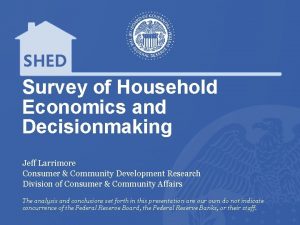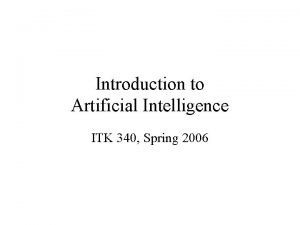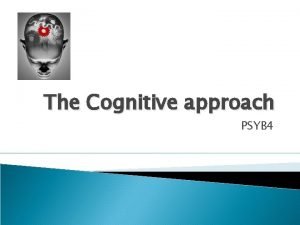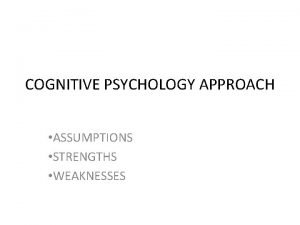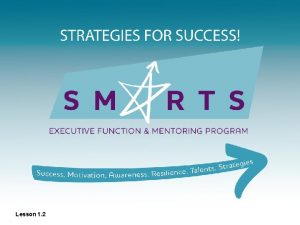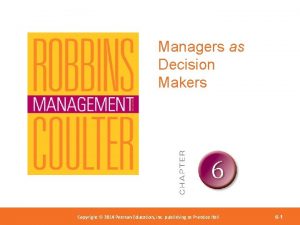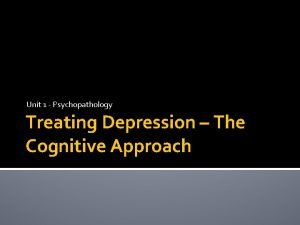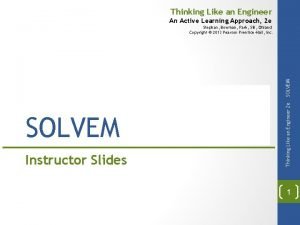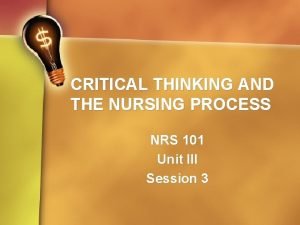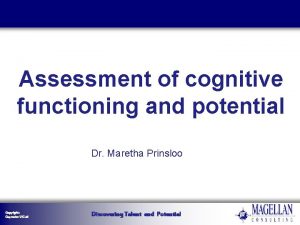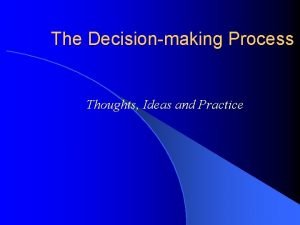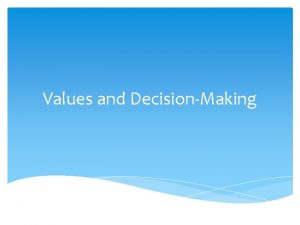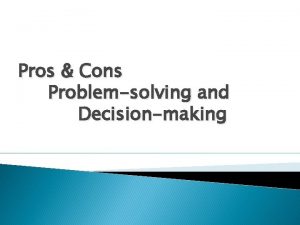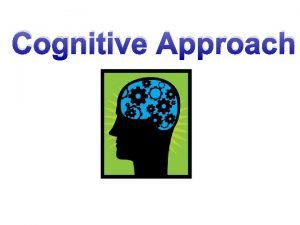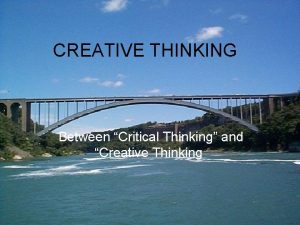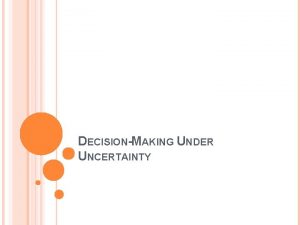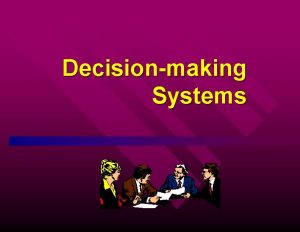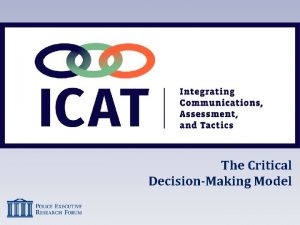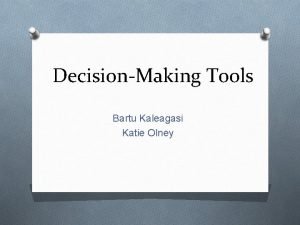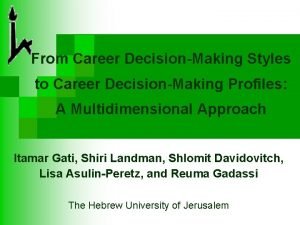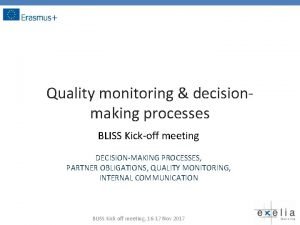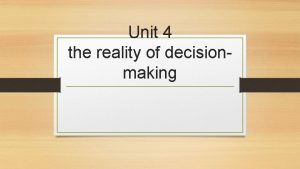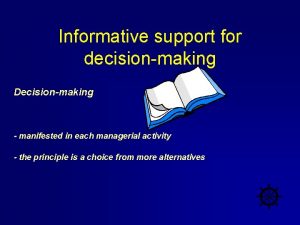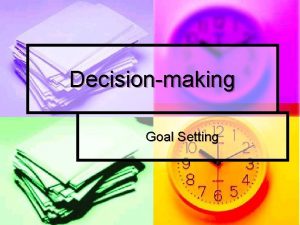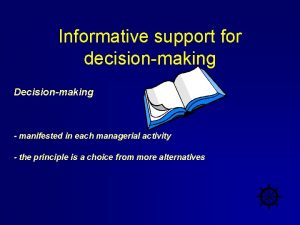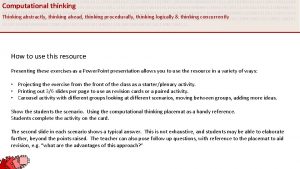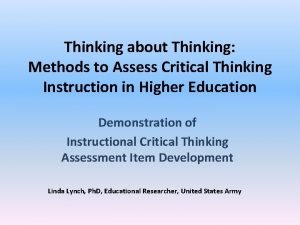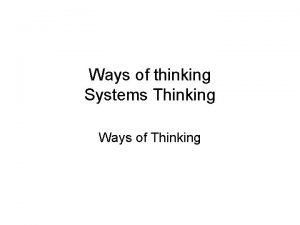COGNITIVE APPROACH COGNITIVE PROCESS Thinking and Decisionmaking I


























- Slides: 26

COGNITIVE APPROACH COGNITIVE PROCESS Thinking and Decisionmaking

I THINK, THEREFORE I AM… See OUP, p 150 - Definitions Normative models, p 150 -151 Descriptive models i. e. what people actually do when thinking

DEALING WITH THE FLOOD! How do we cope relentless flow of information? What does MSM how we deal with the sensory tell us about this?

WHAT HAPPENS WHEN WE PAY ATTENTION? Thinking is the process of using knowledge and information to make plans, interpret the world, and make predictions about the world in general, (Crane, 2018) § Problem solving § Creativity § Reasoning § Decision making

DECISION MAKING AND PROBLEM SOLVING The process of identifying and choosing alternatives based on the values and preferences of the decision-maker Decision making is needed during problemsolving to reach the conclusion Problem-solving is thinking that is directed toward solving specific problems by means of a set of mental strategies. The concepts of problem-solving, decision making and thinking are interconnected

THE DUAL PROCESS MODEL OF THINKING AND DECISION MAKING Stanovich & West (2000) System 1 and System 2

SYSTEM 1 Automatic, intuitive and effortless Often employs heuristics that is, a ‘rule’ used to make decisions or form judgements Heuristics are mental shortcuts that involve focusing on one aspect of a complex problem and ignoring others (Lewis, 2008) Quick and potentially efficient but may be prone to errors

SYSTEM 1 CONT’D Assumptions do not match the reality of a specific situation Such errors can lead to grave consequences in dayto-day life Often we feel very certain that we are right when we use system one thinking When cognitive load is high, we may use System 1 (Gilbert and Gill 2000)

SYSTEM 2 slower, conscious and rational More effortful thinking carefully about all of the possible ways we could interpret a situation Gradual elimination of possibilities based on sensory evidence until we arrive at a solution

SYSTEM 2 CONT’D allows careful analysis of the world around us, allows us to think about … § what is happening § why it is happening § what is most likely to happen next § how we might influence the situation Less likely to create feelings of certitude and confidence

USING BOTH SYSTEMS TOGETHER System 1 is activated first and will reach a quick conclusion System 2 will then go into further analysis to hopefully reach a "more correct" conclusion System 1 processing and its resulting ‘answer’ can often interfere with system 2 processing.

WASON’S CARD SELECTION TASK (1968)

MOST PEOPLE SAY… E 4 But they are only half right. E is correct but 4 is wrong. The matching bias - in an abstract problem, we tend to be overly influenced by the wording (or context) of the question, e. g.

? Odd Even ? Vowel Consonan ? Odd Even ? Vowel Consonant

SYSTEM 1 THINKING Evans and Wason (1976) found that when asked why they chose the cards that they did, they were not able to clearly explain their choices; Suggests they were using system 1 thinking in this abstract task. important evidence for the dual process model Most people make the decision of which cards to choose without any reasoning - but as an automatic response to the context of the question (system 1) Wason (1968) found that even when he trained people how to answer this question, when he changed the context, the same mistakes were made. For example, can you solve this one?

ABSTRACT VERSUS CONCRETE/SOCIAL If you are drinking beer you must be at least 21 <21 >21 ? ? <21 >21 ? Beer Coke

SYSTEM 1 SEEMS TO WORK FINE ON NONABSTRACT PROBLEMS However, it is possible the Bar/ID task is only easy because it is a familiar situation to many of the undergraduate students who were in the sample what happens when you use an unfamiliar task?

CASSAVA ROOT EATING RULE In t he Brazilian Jujube tribe, people who have served the tri be i n a significant way are allo wed to e at cassava root, otherwise this food is banned. Those allow ed t o eat the root have a facial tattoo to identify them. E veryone else eats things like cooked grubs/insects. RULE: If you are eating cassava you must have a facial tattoo

Even though we are not familiar with eating grubs and may not even know what cassava is, most people were able to answer this one correctly. ? ? No tattoo Tattoo ? Cassava Grubs ? Cassav a Grubs

SOCIAL RULE ENFORCEMENT Cosmides and Toobey suggest that we can work out problems quickly and accurately using system 1 thinking if the task is about obeying social rules. Abstract logic not so much use to us however social logic is important to the survival of the groups, e. g. we need to be able to detect and punish the cheaters, who don’t have the groups best interests at heart? Potentially our brains have been shaped by this evolutionary demand So if you want to solve an abstract problem turn it into a social one, e. g. the vowels promised they would ONLY take the even numbers to the cinema.

HEIDER AND SIMMEL https: //www. youtube. com/watch? v=VTNm. Lt 7 QX 8 E

FMRI AND WASON (GOEL ET AL 2000) Participants did logical tasks in an f. MRI scanner. IV: whether the task was abstract or concrete DV: area of the brain that were active Both tasks showed similar activity but there was a clear difference. Abstract task: parietal lobe was active Concrete: left hemisphere temporal lobe was active

DIJKSTERHUIS (2004) See additional sheets and practical activity

ARES ET AL (2013) 71 Pps Shown pairs of yoghurt labels, i. e. info about sugar, fat content Pps have to choose one in each pair Eye movements tracked to see what they were looking at System 2 thinkers searched more info in the time and analysed it more systematically than system 1 thinkers; individual differences

EVALUATION OF THE DUAL PROCESS MODEL Support: § Wason (1968) § Goel et al (2000) Limitations § Reductionist: does not clearly explain how (or even if) these modes of thinking interact or how our thinking and decision making could be influenced by emotion. § The definitions of System 1 and System 2 are not always clear. For example, fast processing indicates the use of System 1 rather than System 2 processes. However, just because a processing is fast does not mean it is done by System 1. Experience can influence System 2 processing to go faster.

MORE EVALUATION P 78 Lawton book § Evaluate the methodology of the studies used as support for the model § Individual differences in decision-making, e. g. satificers versus maximisers § Applications of decision-making research in the real word; psychology as a means of social control- unethical practice (BPS and APA membership). § Reductionist as ignores the importance of biological and social factors in decision-making, e. g. majority influence (conformity) and biological factors such as emotion/hormones.
 Survey of household economics and decisionmaking
Survey of household economics and decisionmaking Thinking humanly: the cognitive modeling approach
Thinking humanly: the cognitive modeling approach Theoretical models of counseling
Theoretical models of counseling Cognitive approach vs behavioral approach
Cognitive approach vs behavioral approach Cognitive and non cognitive religious language
Cognitive and non cognitive religious language Cognitive approach definition
Cognitive approach definition Strengths and weaknesses of cognitive psychology
Strengths and weaknesses of cognitive psychology Cognitive flexibility definition
Cognitive flexibility definition Cognitive thinking
Cognitive thinking Positive thinking vs negative thinking examples
Positive thinking vs negative thinking examples Thinking about your own thinking
Thinking about your own thinking Holistic thinking example
Holistic thinking example Perbedaan critical thinking dan creative thinking
Perbedaan critical thinking dan creative thinking Thinking about you thinking about me
Thinking about you thinking about me Difference between virtual circuit and datagram networks
Difference between virtual circuit and datagram networks Tony wagner's seven survival skills
Tony wagner's seven survival skills Cognitive approach to treating depression
Cognitive approach to treating depression Kelly's cognitive approach to personality
Kelly's cognitive approach to personality Bandura's reciprocal determinism
Bandura's reciprocal determinism Thinking like an engineer: an active learning approach
Thinking like an engineer: an active learning approach Medical diagnosis and nursing diagnosis difference
Medical diagnosis and nursing diagnosis difference Critical thinking definition
Critical thinking definition Waterfall approach marketing example
Waterfall approach marketing example Multiple approach-avoidance conflict
Multiple approach-avoidance conflict Approach research meaning
Approach research meaning Traditional approach in system analysis and design
Traditional approach in system analysis and design Cognitive process profile (cpp) assessment examples
Cognitive process profile (cpp) assessment examples
